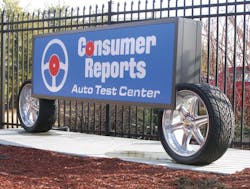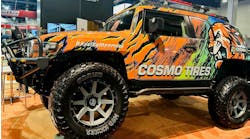As I thought about tackling the subject of tire testing, an old episode of “The Twilight Zone” came to mind.
“A Penny For Your Thoughts” aired in 1961. It followed Hector Poole, a bank clerk who paid for his morning newspaper with a coin that miraculously landed on its edge when he flipped it. Hector then begins to hear the innermost thoughts of those around him on the street and people he thought he knew at work. He spends the rest of the episode struggling with what to do with this newfound, secret and sometimes unsavory information.
After gaining insights about the pros and cons of knowing too much, he passes the same newsstand on his way home and happens to knock over the coin; his gift disappears as quickly as it came.
This brings me to tire testing. Tire manufacturers are notoriously tight-lipped about their testing procedures, processes and data. This was confirmed recently when I tried to gain specific insights from various manufacturers to almost no avail. Aside from the manufacturers, there are third party tests by consumer advocacy companies like Consumer Reports, distributors like The Tire Rack that have their own test facilities on site, and enthusiast magazines like Car and Driver that often perform tests on UHP products. Periodicals like Popular Mechanics and online offerings like About.com frequently test and review tires. Retail websites and car/truck forums are loaded with “real world” tests by actual consumers in the form of online reviews. I think that anyone trying to make sense of the all this information would appreciate Hector’s special insights, if only for a brief time.
Well, newsstands aren’t as ubiquitous as they were in 1961, and it makes no sense to flip a quarter to your iPad to read the New York Times, so the odds of you pulling off a one in a million coin flip to gain access to the collection of tire testing minds just went to one in a centillion (one followed by 303 zeros). Luckily, I have experienced tire testing from the manufacturing side, the third party side and have studied countless magazine articles and .com ramblings on the subject. Here’s my inside perspective.
[PAGEBREAK]
Testing by tire manufacturers:
We’ve all seen the claims — Brand A stops 20 feet shorter than Brand B; Brand C lasts 15,000 miles longer than Brand D. The manufacturers are good at telling you why they were able to achieve the extra mileage or grip. The “super tetrahedral sipe” and the “intergalactic proto-compound” sound impressive and even believable, but they do little to explain how the manufacturer achieved such engineering feats.
Many dealers I’ve talked with have a hard time putting a lot of stock in the manufacturers’ claims about the performance of their tires. While dealers are right to be wary of treating the results as gospel, it’s generally not for the correct reasons.
Here’s what you should know, part 1:
The testing that is cited in marketing materials is often the result of development testing in the course of producing the product. Manufacturers benchmark certain tires that they consider competitive products, and they set goals for many of the attributes that later end up in marketing materials, like braking, mileage, rolling resistance and noise or comfort. As prototypes are developed and tested, the benchmarks and milestones for performance get updated until they are satisfied with the finished product. At that time, there is often a final specification test to quantify the results. The particularly successful facets of the test might make it into the marketing.
While it is expected that Manufacturer A will put its best foot forward in presenting its testing results to dealers and consumers, the testing itself was done in the interest of creating a product that measured up to its performance goals, not in creating a fictional account of engineering superiority.
It makes more sense to eliminate hard data from the marketing than to fabricate it for effect. I just don’t believe that tire manufacturers are that unscrupulous. Confident that the information is accurate, the wrinkle is still in understanding what was tested and knowing how to interpret it.
What you should know, part 2:
If Manufacturer A posts tests results about its tire’s performance, it usually lists a size or sizes used, a competitive product and sometimes a vehicle used for the test. These are all important and telling aspects of the test, but there are still holes to fill in.
Most tire lines have 20 or more sizes. Citing a single size, 215/60R16 for instance, brings into play 15 vehicle models in the years 2008-2012. Is it likely that a Subaru Forester will perform the same as a Chevy Malibu or a VW Passat when fitted with the test size? Possibly, but it is more likely that each vehicle will perform differently depending on many things like suspension, drivetrain, weight, etc.
Then there are the other sizes in the line. Will a 215/60R16 perform like a 195/60R15 or a 225/60R18? Maybe the performance will be similar, but more importantly, the range of vehicles now brought into play gets even wider. It is unlikely that a Chrysler 300 (225/60R18), a Nissan Altima (215/60R16) and a Ford Fiesta (195/60R15) will test similarly in this scenario.
Again, this limited test scenario is not meant to deceive, but is driven by cost and time. Consider how long it would take to test each size of a 40-tire size lineup on a range of vehicles, for braking, tread wear, skid pad, rolling resistance and tread noise. It would be staggering. By the time the testing was over, the product might be obsolete. Manufacturers often choose sizes for testing based on size popularity or target customer vehicles to get the most bang for the buck or most representative driving experience.
Mileage warranty and mileage testing is a hotly debated topic and is often subject to criticism from dealers and consumers, as it is often the most important measurement for many consumer tire segments.
What you should know, part 3:
Mileage testing is extremely complex for tire manufacturers. Nothing is more time consuming and nothing is more variable. Consider that a given tire can be distributed anywhere in the United States. Then consider the different types of roads and conditions: pavement, asphalt, gravel, dirt or concrete, maintained smooth surfaces or littered with potholes. Then consider terrain: mountain, desert, valleys and flatlands. Lastly consider driving style and route: aggressive, defensive, fast, slow, city or highway.
To test for mileage, many manufacturers use a hybrid method of part road test and part algorithm. Testing a representative sample of 80,000-mile tires is time consuming and expensive. Plotting a road course to test the tires is just as important as the tires themselves. If the road course is too easy, real world performance may bring negative results. A course that is too severe will limit revealing the average driver expectation. Some manufacturers use a road course that auto manufacturers use to test OE, others design their own to best match the severity they need for their specifications.
With the road course plotted, the actual driving begins. The more miles driven on the road course, the better the algorithm can predict the final mileage capability. Twelve thousand miles on the road course can provide a very good representation of mileage potential. Twenty-four thousand miles narrows the probability even more. Engineers measure the wear at set intervals during the driving portion of the test and feed the computer. But ultimately, it doesn’t pay off to try and drive an 80K tire 80,000 miles when the math can produce reliable accuracy. Though manufacturer claims are often open to skepticism, the results are certainly trustworthy when viewed with the proper perspective.
[PAGEBREAK]
Third party testing
Many dealers feel more comfortable trusting the results of third party or independent testing. With the marketing angle mostly out of the way, and a more open book on methodology, the independent test eliminates the two main roadblocks that manufacturers face. Perception is only half the story though, as independent methods also present areas where perspective is needed.
What you should know, part 1:
Tire Rack tests are high profile within the industry, and even though many independent tire dealers view Tire Rack as a competitor, they also regard the company as an important source for information. Tire Rack has a very comprehensive, three-part testing process involving road rides, wet track and dry track driving. Road rides represent 90% of the testing lessons. The dealership is incredibly invested in its testing process, having built a test track outside the corporate office. Its people even travel annually to Sweden to test winter capabilities.
As consistent as it is with its methodology, Tire Rack’s testing can fall prey to limited options similar to the manufacturers’ tests. The BMW 3 Series is the vehicle of choice for most tests, which is great fun to drive on the short track and represents the enthusiasts and their performance-oriented vehicles quite well. However, the driving characteristics of the 3 Series test utilizing size 215/60R16 tires are quite different compared to most vehicles that take that size. At least on the track, the rear-wheel-drive vehicle provides much different feedback than a front-wheel-drive Honda Accord, which is a much better representation of the vehicles using this size. As the sizes and segments get closer to UHP, this limitation is less of a problem.
What you should know, part 2:
Consumer Reports (CR) tire tests are very effective at turning consumers on to tires. There probably isn’t a dealer out there who hasn’t had a customer wander into his or her store with a copy of the magazine in his hands, or the dealer’s webpage on a smartphone or tablet. CR’s facilities are top notch, and its testing is also comprehensive. For example, CR tests most of the top-of-mind brands and some of the lesser-known brands.
In my days as a retailer, however, CR-recommended tires did not always add up to a good choice for the customer. There are a number of reasons for this, including the unavailability of certain tire sizes in a ranked brand. Certainly some of this responsibility is up to the consumer and dealer, but there is no denying the disappointment of a driver when the product he wants isn’t available in his vehicle’s tire size and/or speed rating.
As stated earlier, mileage tests are the most difficult to replicate. The methods and surfaces that CR uses to test mileage, while consistent, professionally conducted and representative of its test group, might not be representative for your customer. Also, your shop’s experience with tires on all types of vehicles might have revealed long-term performance issues that the CR tests could not have unveiled.
CR-recommended tires may have the highest total scores, but if your customers don’t care about, say, winter traction, the best tire might not be recommended.
Even though Consumer Reports takes great care in providing a comprehensive test of a tire’s capabilities, its conclusions about recommended products need to be reviewed closely to be useful to your customers. The devil is in the details.
Online user experience reviews
While not proper tests in any way shape or form, user experience reviews of tires do offer insights about the product performance from a singular point of view. And even though many of these opinions are not qualified or do not have any scientific value as to product performance, many dealers and consumers alike pay a lot of credence to the online content, especially when there is sufficient volume.
What you should know:
While popular opinion certainly is a powerful persuader, it is important to be mindful that the untrained can draw improper conclusions about their product experiences. Online reviews are often submitted very quickly after purchase. This can lead to glowing reviews based on the comparison between old unsafe tires or tires with uneven wear and the newly purchased and recently balanced tires. On the flip side, consumers concerned about fuel efficiency may complain when their worn tires, which are very fuel efficient due to the low tread depth, are compared to the new product.
Consumers with unrealistic expectations about a tire due to lack of education can leave unjust negative reviews. More than any other source, online reviews require the most attention to content to be useful to a dealer.
There is a lot to digest here, and maybe you don’t have Hector’s gift of telepathy to get inside the heads of the tire testers. Aside from working for CR or in tire development for a tire manufacturer, you might never know precisely how the test results get calculated. But you can familiarize yourself with the tests that your customers most frequently use as research and help them weed through the information to make the best choice. That’s service guaranteed to get you positive word-of-mouth and earn you customers for life. In the long run, that’s better than reading minds. ■
Robert Abram has worked in the tire industry since 1992, most notably with Dealer Tire LLC and Yokohama Tire Corp. He is B2B product manager for Tire Intelligence LLC.
See more articles by this author at:
Discovering clues on the map to buried treasure



